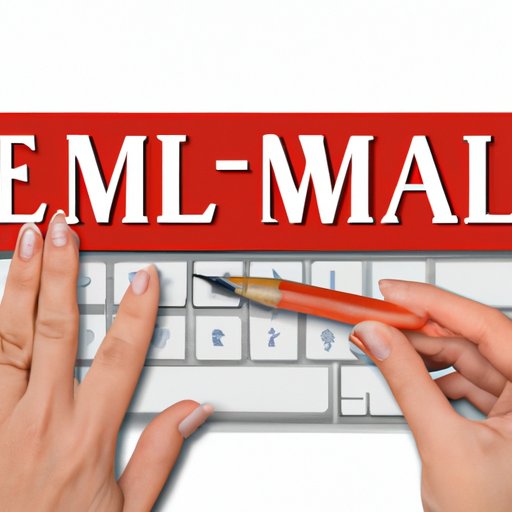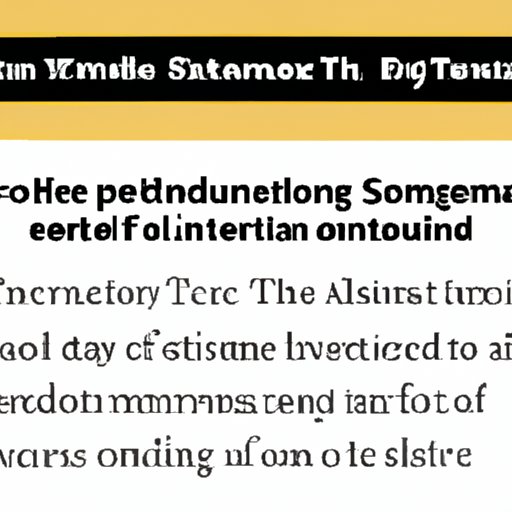
I. Introduction
With email being a primary mode of communication in the professional world, it’s essential to understand how to start a professional email properly. A poorly written email can convey the wrong message, damage your professional reputation, and lose opportunities. Therefore, starting an email professionally and correctly is crucial.
A. Explanation of the problem
Many professionals struggle with how to start a professional email effectively. Making a great impression with a clear email that gets to the point is essential in professional communication. Starting with the wrong tone, a careless greeting, or an email that lacks direction or clarity can sabotage your intentions.
B. Purpose of the article
The purpose of this article is to provide a comprehensive guide on how to start a professional email that captures the reader’s attention. From understanding the importance of greetings, essential tips for crafting your email, to wining over your reader, and writing with a professional tone, we will cover all the essential elements needed to write a professional email that gets the job done.
C. Overview of the Topics Covered
We will begin by discussing the importance of greetings when starting a professional email, how to start an email with essential tips, and crafting a professional email by walking you through a step-by-step guide. Then, we will dive deep into the art of writing a great email that shows empathy, personalization, and a professional tone. Finally, we will wrap up with tips for making your emails attention-grabbing and actionable.
II. The Importance of Greetings: How to Start Your Professional Emails
A. Why Greetings Matter in Professional Emails
Starting an email with the right greeting is essential for making a great impression. A greeting sets the tone for your email and helps establish a professional relationship with the reader. A thoughtful greeting can make the recipient feel valued, and it’s a great way to start building rapport. On the other hand, a lack of greeting or a careless one can be perceived as rude and unprofessional.
B. Examples of Effective Greetings
The type of greeting you decide to use should depend on the level of formality and the recipient’s relationship. Here are some examples of effective greetings for email:
- Dear [Mr./Ms./Dr.] [Last Name]
- Hello [First Name],
- Good morning/afternoon/evening [First Name],
Remember to use a colon instead of a comma after the greeting when addressing a person by their last name and a comma when addressing someone by their first name.
C. Common Mistakes to Avoid
Avoid the following mistakes when greeting in a professional email:
- Using unprofessional greetings, such as “Hey, dude,” or “Hey, dear” or other slangs
- Forgetting to address the recipient altogether.
- Using the wrong title or name of the recipient
- Being too informal with a new acquaintance.
III. Essential Tips for Starting Your Professional Emails
A. Conciseness and Clarity
You want your email to be both concise and specific. Start by writing a clear subject line that summarizes the purpose of the email. Follow with a brief introduction that lets the reader know what the email is about. Avoid lengthy introductions and get to the point.
B. Avoiding Slang and Informal Language
Being overly casual in a professional email can be perceived as rude, unprofessional, and may send the wrong message. Instead, use formal language throughout and maintain professionalism throughout.
C. Tailoring Your Language to the Recipient
Knowing your audience and writing your email accordingly is crucial. Pay close attention to the level of formality that the recipient may appreciate when starting your email with greetings.
IV. Crafting a Professional Email: A Step-by-Step Guide
A. Planning Your Email in Advance
Before you start crafting a professional email, ensure that you have a clear understanding of what you want to achieve. Have a plan in place, identify your audience, anticipate questions or objections. Once you have a clear goal in mind, it’s easier to draft an email that achieves your objective.
B. Structuring Your Email for Maximum Impact
Starting a professional email with a clear structure will help your message come across more clearly. Start with a brief introduction, give context, provide additional information, ending with a clear call-to-action for the readers.
C. Using Templates and Examples Effectively
Having templates for email that you use for different purposes can save time, be more accurate, and reduce the risk of errors. Still, while using templates or examples, ensure you adapt them to the context and the reader. Personalizing the template and providing the necessary details helps to make your email more effective.
V. Starting Out Strong: Best Practices for Beginning Your Professional Emails
A. Effective Opening Sentences
Starting your email with a powerful opening sentence that captures the reader’s attention is essential. Here are some ways to start your email:
- Starting with a question or a provocative statement
- Giving a compliment or something flattering about the reader or their brand
- Offering something of value in return for the reader’s time.
B. Using the Recipient’s Name
Addressing the recipient by name in your email shows respect and is personal. Using their name throughout the email helps to establish rapport and shows your interest in building a relationship with them.
C. Setting Expectations for the Email
Setting the right expectations from the start helps the recipient understand what the email’s purpose is. This helps to avoid confusion and establishes trust with the reader.
VI. Win Your Reader Over: Tips to Effectively Begin Your Professional Emails
A. Personalizing Your Email
Personalizing your email may consist of a common interest, solution to a problem, or addressing the reader’s pain point. It helps your email stand out and shows your interest in the recipient’s needs. This personal touch can also help build a stronger relationship with the reader over time.
B. Injecting Your Personality into the Email
Injecting your personality into the email helps create an emotional connection with your reader and establishes you as a person. Doing what your prospects can relate to, establishing common grounds, creating a sense of familiarity with the recipient helps for future interaction and building relationships.
C. Showing Empathy and Understanding
Using empathy and understanding in your emails makes them feel more personalized. Avoid using language that may seem too salesy or pushy and put yourself in your reader’s shoes to write an email that resonates and gets a quick response.
VII. How to Write an Email that Gets Noticed by Starting Off Right
A. Examples of Attention-Grabbing Opening Sentences
The first sentence is the most important sentence in your email. Here are some attention-grabbing sentences you can use:
- I came across your company, and I was impressed with what I saw.
- There aren’t enough hours in the day, but I wanted to reach out to say…
- I was on your website and wasn’t sure if this would be applicable, but I thought I would reach out anyway.
B. Highlighting Your Value Proposition
Your value proposition should be prominent in your email’s opening. You should clearly state what sets you apart from the competition. An effective value proposition helps to grab the reader’s attention and stand out from competitors.
C. Creating a Sense of Urgency
An effective way to create a sense of urgency in an email is to include an expiration date or deadline. The urgency to remain relevant to the reader helps to motivate the quick response you need.

VIII. Setting the Tone: The Art of Writing a Professional Email
A. Recognizing Cultural Differences
It’s essential to be aware of cultural differences when writing a professional email. Different countries and cultures have different norms. What may be acceptable in one culture may not be acceptable in another. Avoid using jargon or slang that may be unfamiliar to your recipient.
B. Avoiding Misunderstandings
When writing a professional email, ensure that you are clear and precise. Avoid using ambiguous language or using words that could be misunderstood. Be specific and explicit with what you mean.
C. Maintaining a Professional Tone Throughout the Email
Maintaining professionalism throughout your email is essential. Your tone should be courteous and respectful to the reader.
IX. Conclusion
A. Recap of the Article’s Main Points
Starting a professional email is a crucial aspect of effective business communication. From understanding the importance of greetings, essential tips for crafting an email, to writing with a professional tone, we have covered everything you need to know to start a professional email effectively.
B. Encouragement to Put the Tips into Practice
We encourage you to put the tips provided in this article into practice. With the right techniques and approach, you can craft an effective and professional email that gets the results you need.
C. Final Thoughts and Recommendations
Starting a professional email should not be taken lightly. Use the tips provided in this article to write an email that is both effective and professional. Follow the best practices of greetings, clarity, personalization and crafting the right message to convey your intent, and you will be on your way to writing better emails that will contribute to your success.





